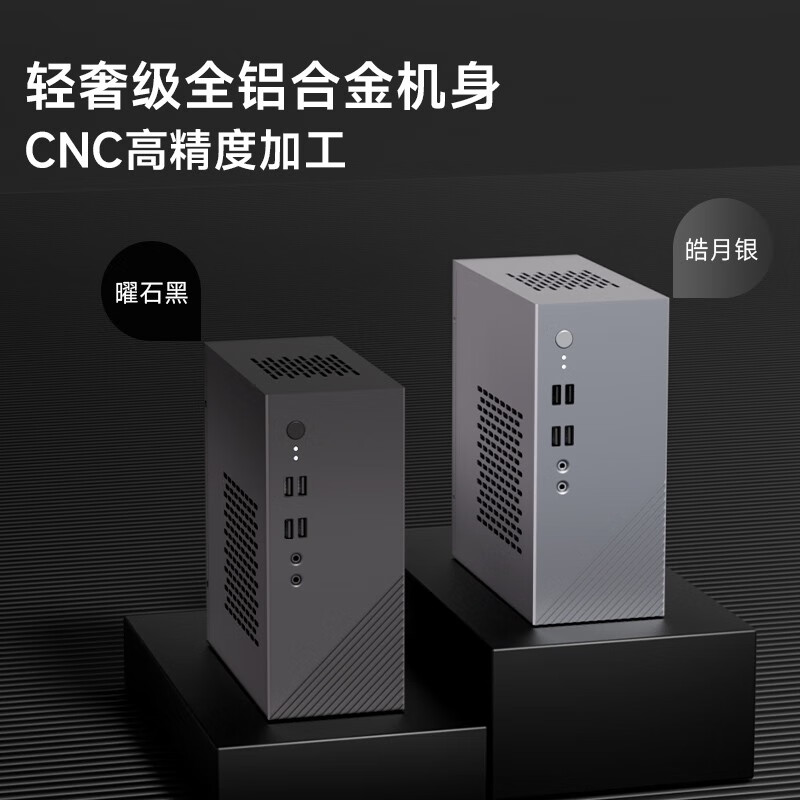
ASRock recently announced its strategic partnership with Topfeel to produce several lineups of mini-PCs for different market segments. The result of this cooperation is the creation of six new product lines, consisting of DeskMix, DeskMff, DeskNAS, DeskMic, DeskAIO, and DeskMax.
Founded in 2014, Topfeel specializes in R&D and manufacturing embedded solutions, workstations, servers, and controllers. Before collaborating with ASRock, Topfeel also cooperated with Gigabyte to work on the brand's QBiX industrial systems.
The DeskMix and DeskMax series cater to workstation users, whereas the DeskMic and DeskMff are designed for mainstream consumers. On the other hand, the DeskAIO and DeskNAS explicitly target the HCI (human-computer interaction) and NAS (network-attached storage) crowd, respectively. The new mini-PCs (via momomo_us) are available with Intel and AMD processors. They arrive in base configurations and barebones presentations so consumers can customize the devices for their specific needs.
The DeskMix features the Intel H610 chipset and supports Intel 12th Generation Alder Lake and 13th Generation Raptor Lake processors. It has two standard DIMM memory slots for DDR4-3200 memory modules and one M.2 interface running at PCIe 3.0 x1. The device includes spacing for two 2.5-inch drives and a full-height, single-slot discrete graphics card. The DeskMix comes with a 1U Flex 250W power supply and supports CPU air coolers with a maximum height of 1.6 inches (40mm).
The DeskMax, on the other hand, is in another league. Consumers can pick between the AMD A620 chipset or the Intel B660 chipset. The first supports AMD Ryzen 3000-, 4000-and 5000-series processors, while the latter accommodates Intel Alder Lake and Raptor Lake chips. Both models sport two DIMM slots for DDR5-5600 memory modules. However, the storage capacity differs significantly.
The DeskMax A620 favors faster M.2 storage, offering one PCIe 4.0 x4 slot, one PCIe 3.0 x2 slot, and one PCIe x2 slot. It only houses two 2.5-inch drives. On the contrary, the DeskMax B660 only rocks one M.2 PCIe 4.0 x4 slot but flaunts support for four 2.5-inch drives. Regardless of the chipset, the DeskMax has enough room for a single discrete graphics card, adhering to a full-height, dual-slot design. Due to the difference in case size, the A620 model accepts graphics cards up to 9.4 inches (240mm), whereas the B660 model is more generous, with a clearance space for up to 12.2 inches (310mm).
The DeskMax utilizes SFX form factor power supplies and features WiFi 6 on the A620 version and WiFi 5 on the B660 version. Bluetooth is present on both. Regarding air cooling, the DeskMax has space for coolers up to 2.2 inches (55mm) in height. The number of USB ports is almost identical on both models, though.




The DeskMic and the DeskMff are the smallest devices out of ASRock's new lot of mini-PCs. Their specifications are pretty similar too. The AMD X300 chipset allows for AMD Ryzen 3000-, 4000-and 5000-series processors, and the Intel H610 chipset for Alder Lake and Raptor Lake parts. Unlike the other recently-announced mini-PCs, the DeskMic and DeskMff favor SODIMM slots instead of the regular DIMM variants.
The DeskMic and the DeskMff provide two SODIMM slots for DDR4-3200 memory modules. The X300 model has one M.2 PCIe 3.0 x4 slot and one 2.5-inch bay, while the H610 models boast an M.2 PCIe 5.0 x4 slot and the same 2.5-inch bay. In the case of the DeskMic H610, consumers can modify the case to house two 2.5-inch drives. Given their target audience, neither DeskMic nor DeskMff support discrete graphics cards.
Feature-wise, both series rely on a DC 5525 120W power supply and have WiFi 6 and Bluetooth connectivity. The DeskMff, however, can only house CPU air coolers with a maximum height of 1.3 inches (33mm), but the DeskMic can do 2.2 inches (55mm). As for USB ports, the DeskMic has two more than the DeskMff.
The DeskMax A620 starts at $205 with the barebones version. The B660 equivalent is $14 more expensive. As for the other models, the DeskMix retails for $195, while the DeskMff X300 and H610 start at $153 and $167, respectively. Finally, the DeskMic X300 has a starting price of $167, but the Intel H610 version is only available with a Core i5-13400, pushing the price tag to $400.
At the time of writing, the product pages for DeskNAS and DeskAIO weren't available. Furthermore, it's uncertain if ASRock will launch the new mini-PCs outside of the Chinese market.







